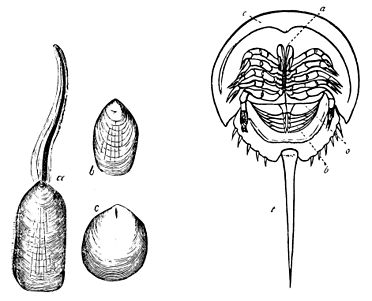or Lingulella (Fig. 3, a), another genus of these animals, has persisted from the Cambrian age (b, c) to our own times, presenting little or no change for the attention of the geological chronicler. The curious king-crabs, or Limuli (Fig. 4), of the West Indies are likewise presented

| Fig. 3.—Lingula. | Fig. 4.—King Crab. |
to our view, with little or no variation, from very early ages of cosmical history; and of the pearly nautilus (Fig. 8)—now remaining as the only existing four-gilled and externally shelled cuttle-fish—the same remark holds good. The fishes, likewise, are not without their parallel instances of lack of change and alteration throughout long ages of time. The well-known case of the genus Beryx presents us Fig. 5.—Beryx. with a fish of high organization, found living in the Atlantic and Pacific Oceans, and which possesses fossil representatives and facsimiles in the chalk (Fig. 5.) From the latter period to the present day, the genus Beryx has therefore undergone little modification or change. The same remark certainly holds good of many of those huge "dragons of the prime" (Figs. 6 and 7), which reveled in the seas of the Trias, Oölite, and Chalk epochs—developed in immense numbers in these eras of earth's history, but disappearing for ever from the lists of living
Fig. 5.—Beryx. with a fish of high organization, found living in the Atlantic and Pacific Oceans, and which possesses fossil representatives and facsimiles in the chalk (Fig. 5.) From the latter period to the present day, the genus Beryx has therefore undergone little modification or change. The same remark certainly holds good of many of those huge "dragons of the prime" (Figs. 6 and 7), which reveled in the seas of the Trias, Oölite, and Chalk epochs—developed in immense numbers in these eras of earth's history, but disappearing for ever from the lists of living
